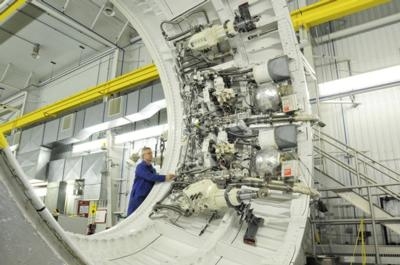Tue, Feb 05, 2013
ATK Says It Has Designed Affordability Into New Avionics Subsystem
The second in a series of development tests for NASA's Space Launch System (SLS) booster program was completed by NASA and ATK on January 30 at ATK's Promontory, Utah, test facility. This key avionics and controls test was designated Flight Control Test 2 (FCT-2) and included a "hot fire" of the fully integrated heritage thrust vector control (TVC), the new SLS booster avionics subsystem and new electronic support equipment (ESE).

FCT-2 focused on replacement of heritage test equipment with new ESE. Much of the equipment replaced was designed and built during the mid- to late-1970s and was successfully used on all Space Shuttle Reusable Solid Rocket Motor (RSRM) and five segment RSRM static motor firings.
"The FCT-2 test marked a definite milestone for ATK and NASA's SLS program," said Fred Brasfield, ATK's vice president, Next-Generation Booster. "Working with Marshall, we have designed and developed a modern system and common interface that allows for multiple uses of the same equipment at all necessary locations for both qualification and operational phases of the program, greatly reducing complexity and costs."
As with the avionics subsystem, affordability was designed in from the onset of developing new ESE. The same ESE design utilized to support static tests will also be used to support certification testing of the avionics subsystem in Utah and at NASA's Marshall Space Flight Center, and ultimately for acceptance check-out of flight hardware at Kennedy Space Center (KSC).
ATK developed the avionics subsystem at facilities in Clearfield and Magna, Utah, with support from NASA Marshall Space Flight Center in Alabama. Key partners supporting ATK throughout this test series include L-3 Cincinnati Electronics in Mason, Ohio, and Southern California Braiding, an IEC Electronics Company in Bell Gardens, California. Cincinnati Electronics provides the avionics boxes, and Southern California Braiding is responsible for the cable harnesses. Both Cincinnati Electronics and Southern California Braiding have been integral to ATK throughout the development lifecycle of the SLS booster.
"Our suppliers have been vital to the success of this program," said Brasfield. "They will remain key contributors through the SLS flight test program."
(Image provided by ATK)
More News
Also: New SAF, Korean Air Buys 103 Boeings, Maryland SP Helo Rescue, OK AWOS Update Gulfstream Aerospace Corporation announced its first customer delivery of the all-new Gulfstream>[...]
"This is just an absolute win win win. If there is a rejected takeoff we now have the confidence that the arrestor system will ensure passenger and crew safety." Source: FAA Admini>[...]
Low Approach An approach over an airport or runway following an instrument approach or a VFR approach including the go-around maneuver where the pilot intentionally does not make c>[...]
Aero Linx: Historic Aircraft Association (HAA) The Historic Aircraft Association (HAA) was founded in 1979 with the aim of furthering the safe flying of historic aircraft in the UK>[...]
While Flying About 1,500 Ft Above Ground Level, A Large Bird Struck The Right Side Of The Airplane Analysis: The pilot reported that while flying about 1,500 ft above ground level,>[...]
 Airborne 08.29.25: G800 Delivery, Alaska F-35 Crash, USCG-RCAF Medevac
Airborne 08.29.25: G800 Delivery, Alaska F-35 Crash, USCG-RCAF Medevac Aero-News: Quote of the Day (08.30.25)
Aero-News: Quote of the Day (08.30.25) ANN's Daily Aero-Term (08.30.25): Low Approach
ANN's Daily Aero-Term (08.30.25): Low Approach ANN's Daily Aero-Linx (08.30.25)
ANN's Daily Aero-Linx (08.30.25) NTSB Final Report: Excalibur Excalibur
NTSB Final Report: Excalibur Excalibur



